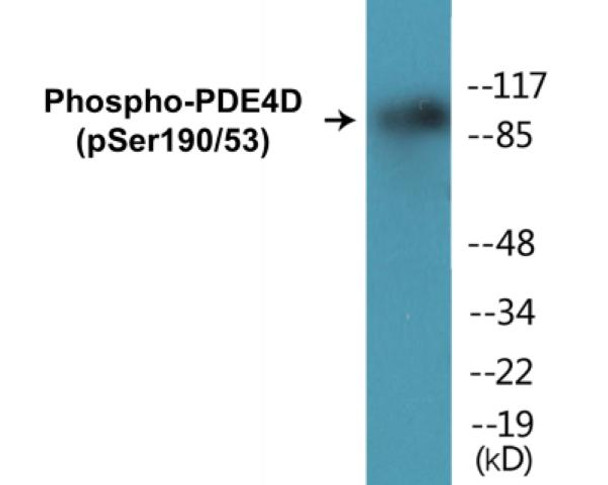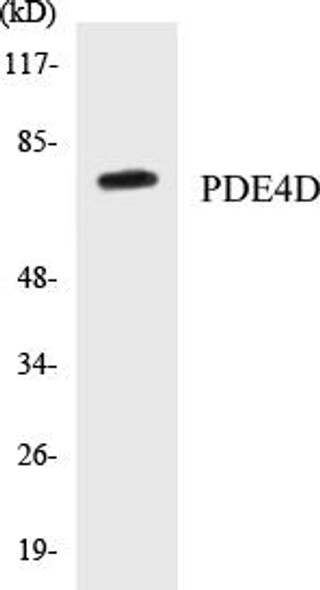Description
PDE4D (Phospho-Ser190/53)Colorimetric Cell-Based ELISA Kit
The PDE4D Phospho-Ser190 Cell-Based ELISA Kit is a powerful tool for the accurate and sensitive detection of phosphorylated PDE4D (phospho-ser190) levels in cell lysates. This kit offers high specificity and reproducibility, allowing researchers to confidently measure levels of this important signaling protein in cell samples.Phosphorylation of PDE4D at serine 190 is known to regulate its activity, impacting various cellular processes such as cell proliferation, differentiation, and apoptosis. Dysregulation of PDE4D signaling has been linked to several diseases, including cancer, inflammatory disorders, and neurological conditions, highlighting the importance of studying this phosphorylation event.
With the PDE4D Phospho-Ser190 Cell-Based ELISA Kit, researchers can accurately quantify levels of phosphorylated PDE4D in cell samples, providing valuable insights into the role of this protein in various physiological and pathological processes. This kit is suitable for a wide range of research applications and offers reliable results for understanding the complex signaling pathways mediated by PDE4D.
| Product Name: | PDE4D (Phospho-Ser190/53)Colorimetric Cell-Based ELISA Kit |
| Product Code: | CBCAB01310 |
| ELISA Type: | Cell-Based |
| Target: | PDE4D (Phospho-Ser190/53) |
| Reactivity: | Human, Mouse, Rat |
| Dynamic Range: | > 5000 Cells |
| Detection Method: | Colorimetric 450 nm |
| Format: | 2 x 96-Well Microplates |
The PDE4D (Phospho-Ser190/53) Colorimetric Cell-Based ELISA Kit is a convenient, lysate-free, high throughput and sensitive assay kit that can detect PDE4D protein phosphorylation and expression profile in cells. The kit can be used for measuring the relative amounts of phosphorylated PDE4D in cultured cells as well as screening for the effects that various treatments, inhibitors (ie. siRNA or chemicals), or activators have on PDE4D phosphorylation.
Qualitative determination of PDE4D (Phospho-Ser190/53) concentration is achieved by an indirect ELISA format. In essence, PDE4D (Phospho-Ser190/53) is captured by PDE4D (Phospho-Ser190/53)-specific primary (1ø) antibodies while the HRP-conjugated secondary (2ø) antibodies bind the Fc region of the 1ø antibody. Through this binding, the HRP enzyme conjugated to the 2ø antibody can catalyze a colorimetric reaction upon substrate addition. Due to the qualitative nature of the Cell-Based ELISA, multiple normalization methods are needed:
| 1. | A monoclonal antibody specific for human GAPDH is included to serve as an internal positive control in normalizing the target absorbance values. |
| 2. | Following the colorimetric measurement of HRP activity via substrate addition, the Crystal Violet whole-cell staining method may be used to determine cell density. After staining, the results can be analysed by normalizing the absorbance values to cell amounts, by which the plating difference can be adjusted. |
| Database Information: | Gene ID: 5144, UniProt ID: Q08499, OMIM: 600129/606799, Unigene: Hs.117545 |
| Gene Symbol: | PDE4B/PDE4C/PDE4D |
| Sub Type: | Phospho |
| UniProt Protein Function: | PDE4D: Hydrolyzes the second messenger cAMP, which is a key regulator of many important physiological processes. Homodimer for the long isoforms. Isoforms with truncated N-termini are monomeric. Isoform 3 is part of a ternary complex containing PRKAR2A, PRKAR2B and AKAP9. Interacts with PDE4DIP. Identified in a complex composed of RYR1, PDE4D, PKA, FKBP1A and protein phosphatase 1 (PP1). Isoform 5, isoform N3 and isoform 12 bind GNB2L1 via their unique N-terminus. Binds ARRB2. Widespread; most abundant in skeletal muscle. Isoform 6 is detected in brain. Isoform 8 is detected in brain, placenta, lung and kidney. Isoform 7 is detected in heart and skeletal muscle. Inhibited by rolipram. Activated by phosphatidic acid. Belongs to the cyclic nucleotide phosphodiesterase family. PDE4 subfamily. 12 isoforms of the human protein are produced by alternative splicing. |
| UniProt Protein Details: | Protein type:EC 3.1.4.53; Nucleotide Metabolism - purine; Phosphodiesterase Chromosomal Location of Human Ortholog: 5q12 Cellular Component: Golgi apparatus; centrosome; myofibril; membrane; apical plasma membrane; voltage-gated calcium channel complex; cytosol Molecular Function:3',5'-cyclic-AMP phosphodiesterase activity; protein binding; enzyme binding; metal ion binding; ubiquitin protein ligase binding; beta-2 adrenergic receptor binding; drug binding; cAMP binding; SH3 domain binding; 3',5'-cyclic-nucleotide phosphodiesterase activity; ATPase binding Biological Process: neutrophil chemotaxis; negative regulation of heart contraction; regulation of heart rate; positive regulation of smooth muscle cell proliferation; multicellular organism growth; cAMP catabolic process; negative regulation of peptidyl-serine phosphorylation; positive regulation of smooth muscle cell migration; T cell receptor signaling pathway; memory; positive regulation of interferon-gamma production; cAMP-mediated signaling; cellular protein complex assembly; smooth muscle contraction; positive regulation of interleukin-2 production; regulation of receptor activity; positive regulation of interleukin-5 production; regulation of G-protein coupled receptor protein signaling pathway; lung development; aging |
| NCBI Summary: | This gene encodes one of four mammalian counterparts to the fruit fly 'dunce' gene. The encoded protein has 3',5'-cyclic-AMP phosphodiesterase activity and degrades cAMP, which acts as a signal transduction molecule in multiple cell types. This gene uses different promoters to generate multiple alternatively spliced transcript variants that encode functional proteins.[provided by RefSeq, Sep 2009] |
| UniProt Code: | Q08499 |
| NCBI GenInfo Identifier: | 12644392 |
| NCBI Gene ID: | 5144 |
| NCBI Accession: | Q08499.2 |
| UniProt Secondary Accession: | Q08499,O43433, Q13549, Q13550, Q13551, Q7Z2L8, Q8IV84 Q8IVA9, Q8IVD2, Q8IVD3, Q96HL4, Q9HCX7, |
| UniProt Related Accession: | Q08499 |
| Molecular Weight: | 809 |
| NCBI Full Name: | cAMP-specific 3',5'-cyclic phosphodiesterase 4D |
| NCBI Synonym Full Names: | phosphodiesterase 4D, cAMP-specific |
| NCBI Official Symbol: | PDE4D |
| NCBI Official Synonym Symbols: | DPDE3; PDE43; STRK1; ACRDYS2; HSPDE4D; PDE4DN2 |
| NCBI Protein Information: | cAMP-specific 3',5'-cyclic phosphodiesterase 4D; cAMP-specific phosphodiesterase PDE4D6; phosphodiesterase 4D, cAMP-specific (phosphodiesterase E3 dunce homolog, Drosophila) |
| UniProt Protein Name: | cAMP-specific 3',5'-cyclic phosphodiesterase 4D |
| UniProt Synonym Protein Names: | DPDE3; PDE43 |
| Protein Family: | cAMP-specific 3',5'-cyclic phosphodiesterase |
| UniProt Gene Name: | PDE4D |
| UniProt Entry Name: | PDE4D_HUMAN |
| Component | Quantity |
| 96-Well Cell Culture Clear-Bottom Microplate | 2 plates |
| 10X TBS | 24 mL |
| Quenching Buffer | 24 mL |
| Blocking Buffer | 50 mL |
| 15X Wash Buffer | 50 mL |
| Primary Antibody Diluent | 12 mL |
| 100x Anti-Phospho Target Antibody | 60 µL |
| 100x Anti-Target Antibody | 60 µL |
| Anti-GAPDH Antibody | 60 µL |
| HRP-Conjugated Anti-Rabbit IgG Antibody | 12 mL |
| HRP-Conjugated Anti-Mouse IgG Antibody | 12 mL |
| SDS Solution | 12 mL |
| Stop Solution | 24 mL |
| Ready-to-Use Substrate | 12 mL |
| Crystal Violet Solution | 12 mL |
| Adhesive Plate Seals | 2 seals |
The following materials and/or equipment are NOT provided in this kit but are necessary to successfully conduct the experiment:
- Microplate reader able to measure absorbance at 450 nm and/or 595 nm for Crystal Violet Cell Staining (Optional)
- Micropipettes with capability of measuring volumes ranging from 1 µL to 1 ml
- 37% formaldehyde (Sigma Cat# F-8775) or formaldehyde from other sources
- Squirt bottle, manifold dispenser, multichannel pipette reservoir or automated microplate washer
- Graph paper or computer software capable of generating or displaying logarithmic functions
- Absorbent papers or vacuum aspirator
- Test tubes or microfuge tubes capable of storing ≥1 ml
- Poly-L-Lysine (Sigma Cat# P4832 for suspension cells)
- Orbital shaker (optional)
- Deionized or sterile water
*Note: Protocols are specific to each batch/lot. For the correct instructions please follow the protocol included in your kit.
| Step | Procedure |
| 1. | Seed 200 µL of 20,000 adherent cells in culture medium in each well of a 96-well plate. The plates included in the kit are sterile and treated for cell culture. For suspension cells and loosely attached cells, coat the plates with 100 µL of 10 µg/ml Poly-L-Lysine (not included) to each well of a 96-well plate for 30 minutes at 37 °C prior to adding cells. |
| 2. | Incubate the cells for overnight at 37 °C, 5% CO2. |
| 3. | Treat the cells as desired. |
| 4. | Remove the cell culture medium and rinse with 200 µL of 1x TBS, twice. |
| 5. | Fix the cells by incubating with 100 µL of Fixing Solution for 20 minutes at room temperature. The 4% formaldehyde is used for adherent cells and 8% formaldehyde is used for suspension cells and loosely attached cells. |
| 6. | Remove the Fixing Solution and wash the plate 3 times with 200 µL 1x Wash Buffer for five minutes each time with gentle shaking on the orbital shaker. The plate can be stored at 4 °C for a week. |
| 7. | Add 100 µL of Quenching Buffer and incubate for 20 minutes at room temperature. |
| 8. | Wash the plate 3 times with 1x Wash Buffer for 5 minutes each time. |
| 9. | Add 200 µL of Blocking Buffer and incubate for 1 hour at room temperature. |
| 10. | Wash 3 times with 200 µL of 1x Wash Buffer for 5 minutes each time. |
| 11. | Add 50 µL of 1x primary antibodies Anti-PDE4D (Phospho-Ser190/53) Antibody, Anti-PDE4D Antibody and/or Anti-GAPDH Antibody) to the corresponding wells, cover with Parafilm and incubate for 16 hours (overnight) at 4 °C. If the target expression is known to be high, incubate for 2 hours at room temperature. |
| 12. | Wash 3 times with 200 µL of 1x Wash Buffer for 5 minutes each time. |
| 13. | Add 50 µL of 1x secondary antibodies (HRP-Conjugated AntiRabbit IgG Antibody or HRP-Conjugated Anti-Mouse IgG Antibody) to corresponding wells and incubate for 1.5 hours at room temperature. |
| 14. | Wash 3 times with 200 µL of 1x Wash Buffer for 5 minutes each time. |
| 15. | Add 50 µL of Ready-to-Use Substrate to each well and incubate for 30 minutes at room temperature in the dark. |
| 16. | Add 50 µL of Stop Solution to each well and read OD at 450 nm immediately using the microplate reader. |
(Additional Crystal Violet staining may be performed if desired – details of this may be found in the kit technical manual.)






